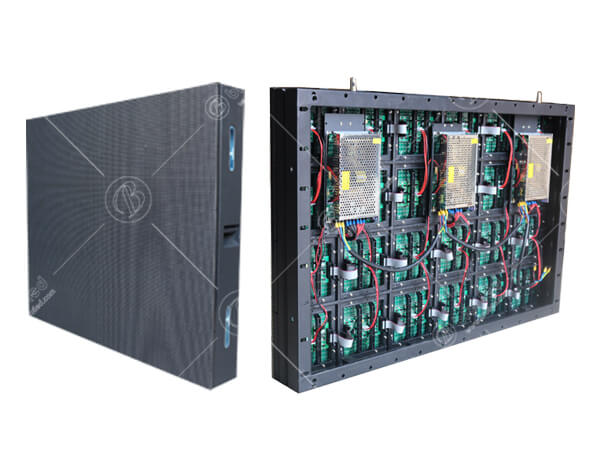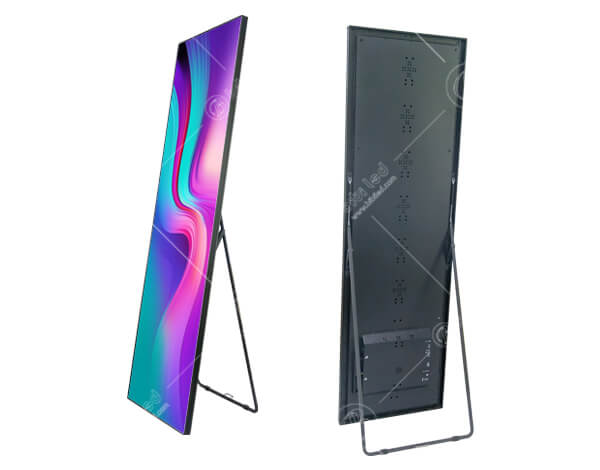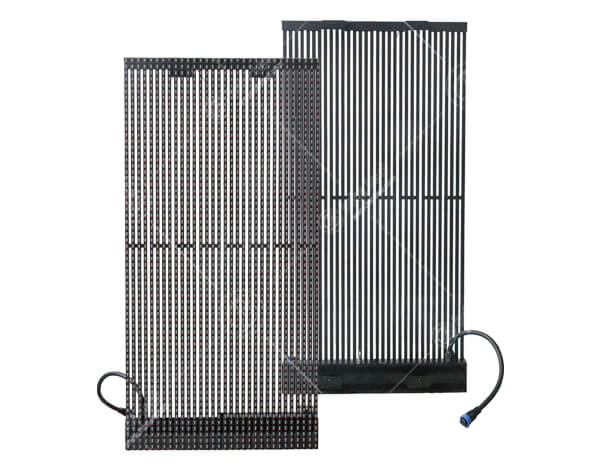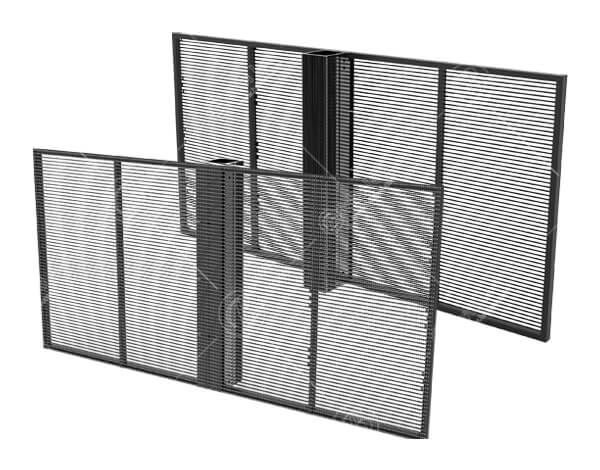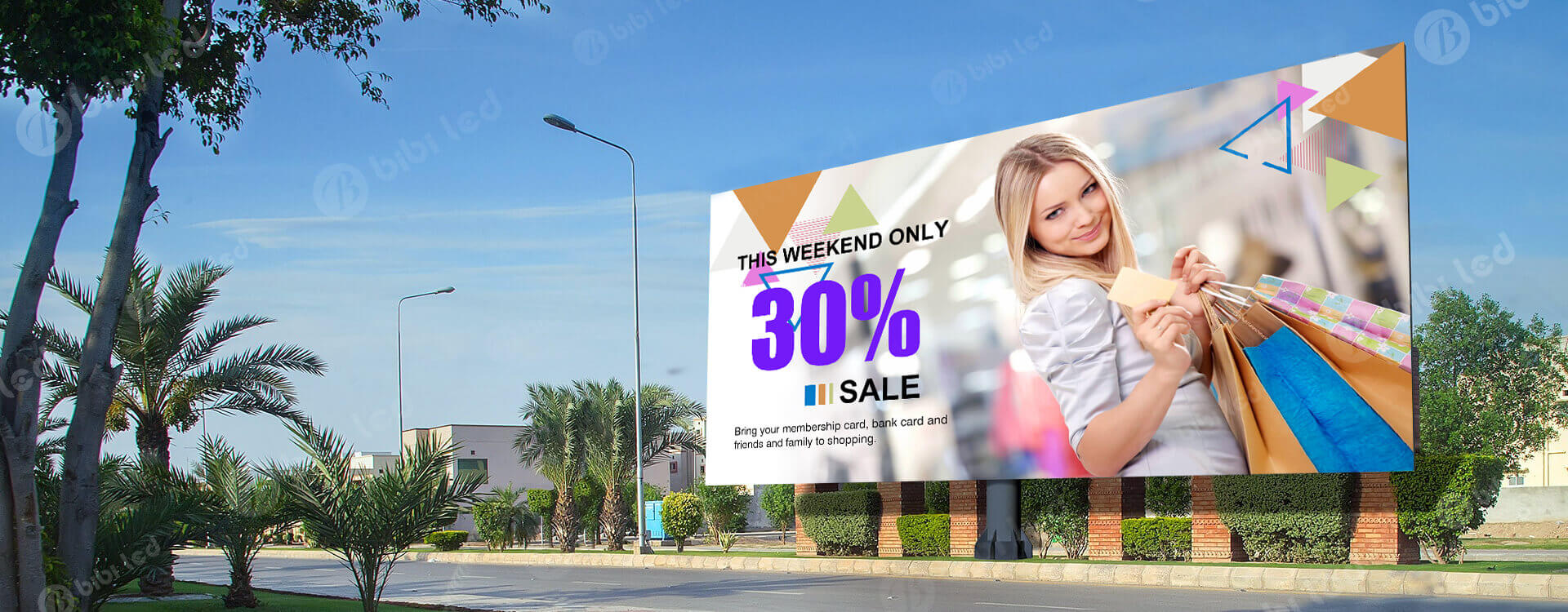
Commercial LED Display
Outdoor LED BIllboard
| ITEM | UNIT | Description |
|---|---|---|
| Pixel Pitch | mm | 3/ 4/ 5/ 6/ 6.67/ 8/ 10/ 16 |
| Brightness | Nits | Up to 6500 |
| Refresh Rate | Hz | >1920 |
| Key Point | Most common outdoor LED billboard | |
Key Features
- Customized Cabinet Size and Design.
- Steel/ Aluminum Cabinet.
- Back Service.
- SMD 3in1 Technology.
- Waterproof with IP65.
- Wide View Angle.
Indoor Fixed LED Screen
| ITEM | UNIT | Description |
|---|---|---|
| Pixel Pitch | mm | 3/ 4/ 5 |
| Refresh Rate | Hz | >1920 |
| LEDs | N/A | Black LEDs |
| Key Point | High definition video visual advertising, indoor fixed installation | |
Key Features
- Customized Cabinet Size.
- Steel Cabinet.
- Front and Back Service.
- SMD 3in1 Technology.
- Black LEDs with Better Contrast.
- Seamless Visual Quality Performance.
LED Poster
| ITEM | UNIT | Description |
|---|---|---|
| Pixel Pitch | mm | 1.75/ 2/ 2.5 |
| Refresh Rate | Hz | >3840 |
| Cabinet Material | N/A | Die-casting aluminum |
| Key Point | Light weight design, easy to move and carry, plug to play | |
Key Features
- Plug-and-Play Design.
- Several Installation Way: Wall Mounted and Floor Stand Itself.
- Die-casting Aluminum Cabinet, Better Flatness.
- Light Weight Of Cabinet, Easy to Move.
- Cloud System Operation, One Control All.
LED Curtain Screen
| ITEM | UNIT | Description |
|---|---|---|
| Pixel Pitch | mm | 15~15/ 15~31/ 31~31 |
| Brightness | Nits | Up to 10000 |
| LEDs | N/A | DIP LEDs |
| Key Point | Super light weight, release the pressure of the building | |
Key Features
- 500x1000mm Fixed Cabinet Size.
- Front and Back Service.
- DIP Technology More Durable.
- Super Light Weight of the Cabinet.
- Water Proof IP67 Rate.
Transparent LED Screen
| ITEM | UNIT | Description |
|---|---|---|
| Pixel Pitch | mm | 3.91~7.81/ 7.8~7.8/ 10.4~10.4 |
| Brightness | Nits | Up to 5000 |
| Transparency | % | >70 |
| Key Point | Fashion design, looks clean after installation, makes the light come in through of the building | |
Key Features
- Over 70% Transparency Rate to Make the Sunshine Get Through.
- Quick and Easy to Install.
- Hide Cable Design, More Clean Look Like.
- Super Light Weight of the Cabinet.
- Customized Cabinet Size Accepted.
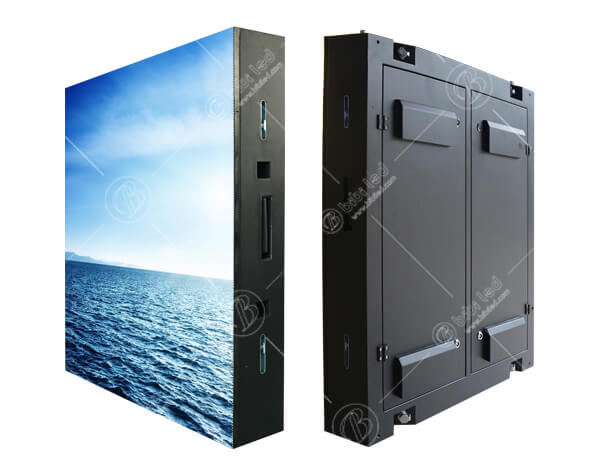
Outdoor Front Maintenance LED Display
CF Series
| ITEM | UNIT | Description |
|---|---|---|
| Pixel Pitch | mm | 4.16/ 5 / 6.25/ 8.33/ 10 |
| Refresh Rate | hz | >3840 |
| Brightness | nit | Up to 6500 |
| Key point | Front service, wall mount installation, no need to make the maintenance space at the back | |
Key Features
- Customized Cabinet Size.
- Aluminum Cabinet.
- Front&Rear dual Service.
- SMD 3in1 Technology.
- Waterproof.
- Wide View Angle.
What is a commercial LED display?
Commercial LED displays are a type of LED screen, which are generally used to play corporate or brand promotional videos or advertising videos.
Because it has the advantages of high brightness, wide viewing angle, and bright colors, it can also be customized.
It is large and small and has excellent water and heat resistance with an extraordinary performance.
It is widely used outside of buildings, streets, squares, cinemas, shopping malls, and other places and is an indispensable tool for outdoor advertising.
- Chapter 1 What are the types of commercial LED display?
- Chapter 2 What is the commercial LED display could bring us?
- Chapter 3 How to make the profit by commercial LED display?
- Chapter 4 What are the usage of commercial LED screens
- Chapter 5 Is the commercial LED display demand worth being filled and invest?
- Chapter 6 What are the application scenarios of commercial LED screens?
- Chapter 7 Commercial LED Screen: The History of Legend.
Chapter 1 What are the types of commercial LED display?
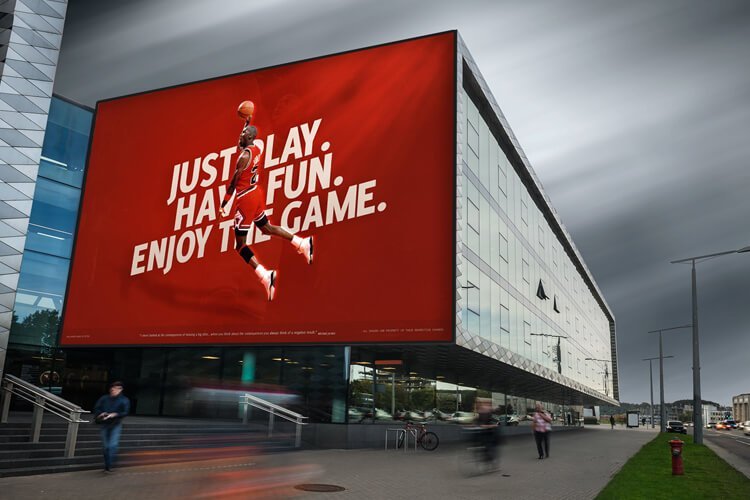
CS Series is the most common and popular outdoor fixed LED display.
It is used for outdoor commercial places, supermarkets, shopping malls, banks, hotels, etc.
CS Series is the right one to choose if you need the outdoor advertising LED billboard to spread your brand.
One of the more popular display devices today is the indoor LED screen. But what exactly is this device?
Technically, it is a robust real-time dynamic data display device that is designed for indoor use. It is mainly used for displaying videos or images.
CW Series belong to commercial LED display but designs as a super lightweight fixed installation LED display.
It releases the pressure of the building wall.
CW Series is the right one to choose if you need the super lightweight advertising LED billboard.
Chapter 2 What is the commercial LED display could bring us?

Have you experienced this before?
The various brand logos and advertisement lines attract you in the shopping mall, and only the most robust publicity means can attract your eyes.
Similarly, in the face of intense visual conflicts and content-rich LED advertising screens, you are usually not interested in the advertising flyers sent by shopping guides.
This is why we need commercial advertising LED screens to attract consumers’ attention and bring us traffic and profit.
In general, business owners provide commercial advertising LED screens and advertising spaces.
Advertisers place advertisements; consumers see and consume ads.
Whether it can attract consumers depends almost on the display effect of the LED advertising screen.
Consumers are willing to pay attention only if the advertising LED screen’s effect is good enough, and the content is attractive.
Is the effect of commercial advertising LED screens excellent?
What are its essential characteristics?
Several comparisons illustrate this.
First of all, commercial advertising LED screens are self-illuminating and dazzling at night.
Conventional flyers and hi-tech newspapers can only be displayed through ordinary fabrics such as paper, which leads to two fatal disadvantages:
One is that the light source limits the color effect.
The darker the light, the worse the effect.
The second one is a static display, which is challenging to attract attention.
Commercial advertising LED screens have a surprising number of LED lamp beads; hundreds, even thousands of lamp beads are illuminated at the same time after being connected to the power supply.
The high-resolution painting surface brings very delicate display effects, and you can feel the neon light beyond 100 meters.
This isn’t easy to achieve with traditional outdoor advertising.
Even more extreme, in the evening, commercial advertising LED screens to display advertisements in bright colors, becoming a beautiful landscape that lights up the city.
Paper and banner ads are dim and dark at night.
So, why do you choose a commercial LED display screen that is “standby” 24 hours a day?
Secondly, the size is infinitely large.
This allows you to be no longer limited to the limited area of flyers, sea news, and LED posters and expand the display screen’s size infinitely.
Of course, advertising LED screens usually have at least one square meter, and their area is much larger than traditional promotional materials.
According to visual habits, people are also easier to focus on larger and more prominent objects.
Therefore, advertising LED screens have natural advantages.
On the other hand, this also means that you can personalize the screen area, convenient and easy to save costs.
Again, the content can be changed.
The pain points of traditional advertisers are obvious.
In essence, every time you update the advertising content, you must reprint materials such as advertising leaflets, and then you need to arrange specific people.
Staff to distribute leaflets or even newer newspapers and banners.
At the same time, it is not possible to ensure that the flyers reach each user’s hands.
This process wastes a lot of time and is very inefficient.
What about commercial LED screens?
On the computer side, you only need to change the content with one click, and you can achieve the dissemination of advertising content in one second.
The huge amount of time saved in the middle will undoubtedly win you more users.
Fourth, the advertising LED screen can play videos and present dynamic content.
Traditional advertising materials can only display static text and graphics.
However, commercial advertising screens have achieved a leap in advertising content from static to dynamic.
Its importance is self-evident.
First, just as a funny cat sticks to a cat, it’s easy for people to follow dynamic objects.
Second, the dynamic video gives people more sensory excitement, conveys richer and more abundant information, and can stimulate people’s resonance and desire to buy.
Fifth, the amount of information is more abundant, and more content is displayed.
The creation of traditional advertisements is the same as the editing of newspapers and magazines.
We must carefully consider each location’s content, including the choice of different content and its size.
The reason is obvious:
First, the area of the flyers and sea news reports is limited;
Second, more information means that fonts and graphics must be smaller.
Once this is the case, it is challenging to ensure clarity, and it is difficult for users to see clearly.
But this is not a problem for commercial LED advertising screens.
It takes “flat square rice” as a unit to naturally present more content.
A large number of lamp beads and brightness also guarantee its resolution and sharpness.
Commercial advertising LED screens also feature low power consumption, high brightness, wide viewing angle, and seamless stitching.
Chapter 3 How to make the profit by commercial LED display?
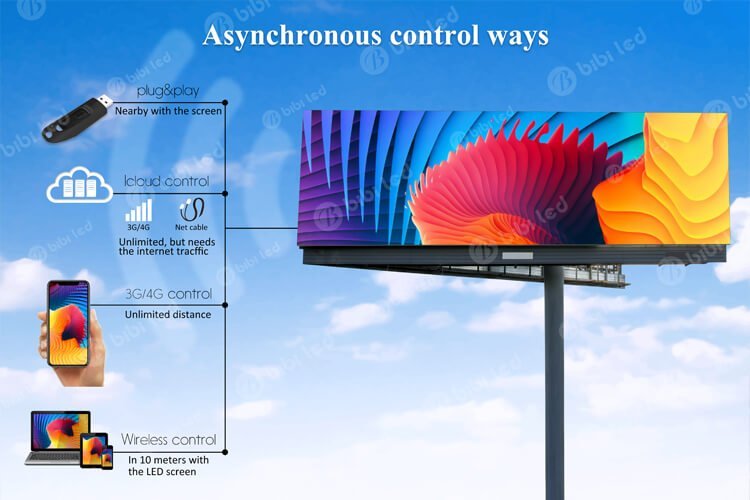
Generally speaking, advertisers will buy commercial advertising LED screens and have permanent use of rights for the LED screens.
They installed the LED screens in a bustling area with a large passenger flow.
These areas have high exposure and a good promotion effect.
After that, you can accept the commission of advertising and receive commissions.
On the price issue that everyone cares about, we have compiled a set of data:
First, the cost of buying LED advertising screens.
Based on various types of data, the estimated LED screen price of the purchase screen as below:
$ 5,240 4x2m
$ 13,100 5x4m
$ 15,720 6x4m
$ 26,200 8x5m
Second, how much profit can commercial LED screens bring?
It usually takes about 10,000 USD a month to purchase advertising positions.
You can accept 10-20 advertisements at the same time every month, even more.
This means that in just one or two months, you can fill in the costs and make a long-term profit.
Market prices fluctuate, this script is for reference only, please contact us for details.
Chapter 4 What are the usage of commercial LED screens
The applications of commercial advertising LED screens are very wide.
The primary use is to replace and surpass traditional advertising methods and to make a qualitative leap in publicity.
01, Outdoor advertising
Such as some large-scale buildings, pillar-type billboards, real estate advertisements, and beautiful publicity displays.
LED advertising screen effect is better
Imagine that traditional propaganda methods are challenging to achieve good results because:
Limited people are unable to distribute leaflets, which takes time and effort.
Not to mention, leaflets often fall into the trash, and they do not work at all.
Banners and posters are dim in color, not only can’t attract attention in the urban area where neon lights gather, and can only be used once, extravagant and wasteful.
LED advertising screens are more adaptable to people’s living habits.
With the increasing development of urban transportation, buses, taxis, subways, high-speed rail, and airplanes are becoming the norm.
People are rushing in a hurry, and it is difficult for them to be willing to pay attention to leaflets and news.
There are almost various LED screens in the stations, railways, etc.
It has melted into the blood of the city and penetrated the life of the people.
LED commercial screens have a more extensive range of influence.
Large outdoor advertising can be seen from a hundred meters away, but traditional advertising materials can not break through space limitations.
That’s the difference between an LED billboard and a static billboard.
This is just like when you look into the distance; it is often easier to see and see those towering buildings that are soaring into the sky, instead of small bungalows hidden in the city.
This also determines that more people can see the advertisements on this LED screen so that the advertisements can reach a wider range of people in a wider range.
02, Urban Public Facilities
Commercial advertising LED screens are also widely installed on city squares and main roads.
Government departments can use it to promote public welfare advertisements, play movies, broadcast major news, and deliver important news.
The first aspect enriches people’s entertainment and life and improves the city’s quality of life.
Another aspect that can help build urban safety and increase people’s attention to important current events.
Just like the new coronavirus that has swept the world this time, governments in many regions have promoted the development of news and broadcasting facilities in various locations in the city.
Information on protective measures and the number of newly diagnosed pupae.
This has played an essential role in the prevention and control of the epidemic.
Chapter 5: Is the commercial LED display demand worth being filled and invest?
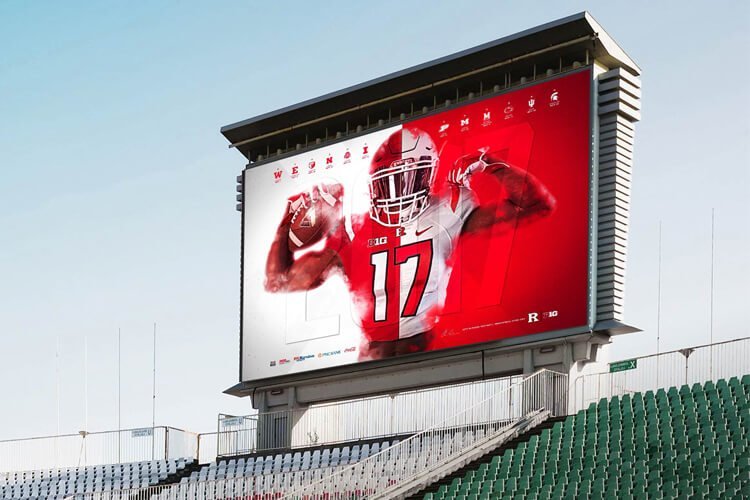
For enterprises, when considering whether to purchase large fixed assets, they need to consider whether it is worth investing in.
There are three main issues involved:
First, is it cost-effective in the long run?
Second, what is the ratio of input to output?
Is there a risk of loss?
Third, how do competition opponents do? Can this strategy be adapted to the market structure?
Diminishing Marginal Costs: Low Costs and Considerable Profits
Long-term use, the longer the use, the more cost-effective
After the LED screen is purchased as a fixed asset, it can be used for a long time.
In the beginning, it takes a period of time to make a profit to exceed the cost of buying a screen and turn it into a profit.
The longer the time, the more profit will accumulate, and the LED screen purchase cost will not be worth mentioning.
In the end, you don’t need to pay any more for the screen, except for the fixed electricity fee and venue rent per month.
This is equivalent to the initial purchase cost being allocated to each business cooperation.
The longer the use time, the lower the cost of the screen each time.
Significant investment and output: spend less money and do more
Multi-use on one screen to meet diverse needs
Commercial LED screens are a medium.
In addition to playing advertisements, you can also perform various publicity, publicity announcements, news announcements, and live entertainment.
LED screens for shopping malls often carry out promotional activities and even use stage forms.
At this time, the commercial advertising screen can be broadcast live in real-time, attracting more people.
Plazas and parks are often a place for people to entertain and entertain.
Some large-scale events will also be held here.
Commercial advertising LED screens can be used as stage LED screens.
It echoes the stage and enhances the atmosphere.
Because of its diversified usage methods and rich functions, commercial advertising LED screens have greatly reduced the search costs of users, thus facilitating work.
Good communication results, so it’s not easy to earn foot traffic.
As mentioned in the previous article, commercial LED screens can change content, display more content, attract more eye-catching, and have an excellent communication effect.
It is very cost-effective to invest in fixed costs in exchange for considerable income.
03, Excellent communication strategy
This is a common-seeking strategy that gains a place in market competition.
meaning is:
Owning a competitive market that does not have competitors can fill the vacancies in the market, which can increase the competitive power and be chosen by customers.
When competitive opponents have the same advantages as their counterparts, they need to polish their strengths and strengths, far surpassing their competitive counterparts, to win.
Commercial advertising screens are already everywhere, so if you want to get better communication effects and get more versatile users, then it is worth your purchase.
Consumers Unstoppable Killers
According to research, three main factors affect consumers: transmission intensity, frequency, and substitutability.
The intensity and substitutability of communication mainly involve the effect of communication and display.
Compared with other methods, commercial advertising screens are undoubtedly excellent.
The frequency of propagation refers to the frequency of occurrence.
It is difficult for any large LED screen to be unnoticed, as long as you choose ads space and ads time.
It’s easy to make an impression in the minds of consumers.
Chapter 6: What are the application scenarios of commercial LED screens?
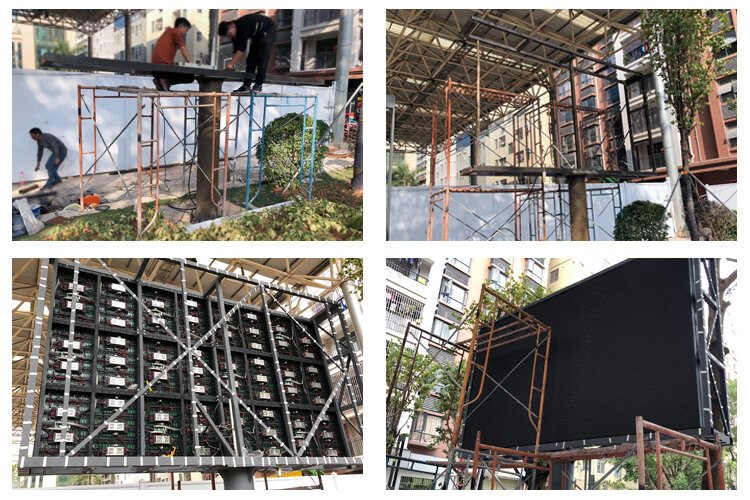
Outdoors are places where commercial LED advertising screens appear at high frequencies.
They fit the trajectory of people’s travels and can be used for advertising at all times.
For example, when people walk along the road, they will see the advertising screen outside the building.
If they choose the subway, they will see the advertising screen in the subway station.
Then, we will arrive at our target site via the traffic vehicle.
It may be a car station; it may also be an outdoor place and entertainment place, but no matter which one, people will be surrounded by LED advertising screens.
This also shows that the application scenarios of commercial LED screens are also extensive.
The following pages introduce his application from three different scenarios.
01, Exit: along the subway, railway, airport.
The subway, high-speed rail, scooter cars, and airports are undoubtedly the places where people move most frequently.
In this scene, people are often eager to take action, so most of the ads are for brand promotion and deepening the purpose.
According to news reports, Beijing Gyeonggi Capital Airport had over 100 million passenger throughput in 2018.
Although this does not represent the average world level, it is still conceivable to know how large the station’s traffic volume is.
If an advertising LED screen is arranged at the airport, it will achieve hundreds of millions of exposures in one year, and the coverage will be beyond the imagination.
Many advertisers also favor this place.
Its advertising costs are naturally higher than normal, which can bring great benefits to screen owners.
Its specific application will involve inside the station, along the railway line.
The first is inside the car station/Airport.
Advertising LED screens mounted on the walls of stations/airports are the most common and can display both advertising and trip information.
In some stations/airports, there are also columns or hanging LED advertising lighthouses.
If conditions permit, they can also rotate and lift, which is very eye-catching.
Advertisements for cars, skincare products, light luxury brands, and hotel chains are the most common.
This type of advertising screen can be seen from the head up, and the transmission effect is perfect.
What’s more important is that passengers often take the initiative to search for trip information after entering the station, and they will almost certainly see the advertisement screen.
Therefore, the advertising reach in this scenario is much higher than in other situations.
The railway line followed them.
Some railway towers will be built with pillar-shaped towers.
Because the area is large, the brightness is high, and the viewing angle is wide, often the railway is far away, and passengers can also see the advertisement’s content.
02, Outdoor places: shopping malls, outside buildings, parks
Outdoor places cover people’s work and rest time.
LED screen for working scene.
To work, you need to enter a dedicated office space, such as an office building.
Besides, some office buildings, industrial parks, and technology parks will be equipped with unique LED screens to display corporate and brand style.
It is also common practice to install advertising screens on the outside of office buildings.
In this type of scene, it is common to see cutting-edge information on science and technology, construction or promotional materials for parks, and advertising for well-known brands in the park.
LED screen for the casual scene.
The squares and parks are places where people often get involved when they relax.
The public facilities and entertainment equipment in this scene are well equipped.
Commercial LED displays are mainly built separately here, with columns and towers being the most common.
In such scenarios, government public welfare, essential notices, commercials, advertisements, and entertainment movies are common.
03, Entertainment venues: shopping malls, hotels, cinemas, theaters, exhibitions.
Entertainment and life are indispensable for people and life.
People who are involved in entertainment venues usually have more entertainment and willingness to pay for goods.
And the entertainment place is often the location of the products displayed by the advertisement.
Therefore, advertising in entertainment venues is essential, and it is an important part of customers from seeing advertising to consumption.
LED screen for a shopping center.
Shopping malls have the largest number and the most frequent advertisements divided into indoor and outdoor sections.
Indoors are mostly wall-mounted.
In terms of content, they often directly display newly launched products and well-known brands and advertisements.
It is usually not close to the same type of store in terms of location, so it is difficult for consumers to find and buy.
Like the advertising screens on the outside of buildings, outdoors are extremely easy to attract consumers to enter shopping malls.
LED screen for exhibition, cinema, theater.
Generally speaking, these three types of scenes will involve the show’s price, the introduction of the starring crowd (the exhibition is the main creative team).
Therefore, the screen can display fares, popularity charts, team demonstrations, interview videos.
Secondly, theaters and movie theaters are mainly based on drama.
Therefore, commercial advertising screens are mostly used to display the trailer and performance videos of the main push work and display the advertising information.
Finally, the exhibition will cover many fields, such as art, technology, and commerce.
In addition to playing advertisements related to the exhibition’s theme, it can also be used as an LED background or used for the promotion of promotional messages.
It can also be used for live broadcasts if necessary.
Hotel advertising screens are usually installed in the lobby, large conference rooms, and entertainment rooms.
Most hotels use advertising screens to display advertisements, entertainment videos, and more.
Well-known hotels will also use it to broadcast hotel history and hotel branding videos.
Some high-end hotels have richer and more comprehensive functional areas and may also have Chinese restaurants, Western restaurants, Japanese restaurants, banquet halls, and KTV entertainment.
Because consumers involved in this area have more powerful spending power, advertising LED screens are often installed in this scenario.
The banquet hall often undertakes weddings and annual company conferences and KTV entertainment rooms that have stronger song and dance attributes.
04 Why is it necessary to use a commercial LED display?
Obviously, in the above-mentioned various scenarios, commercial LED screens show strong adaptability, a wide range of applications, and rich expression effects.
We must use commercial advertising screens because it better reflects the characteristics of fashion, cutting-edge, high-end.
We can’t imagine that shopping malls are not decorated with LED advertising screens and only use flyers.
We cannot imagine that an exhibition that symbolizes the power of science and technology, progress, art, and imagination does not have commercial LED screens, but the only static performance that lacks the poster’s performance.
We can’t even imagine that there is not even a colorful screen that lights up the night in some high-end venues, as if in the last century.
Commercial LED screens necessary to show your wonderful creativity and exquisite brand.
Chapter 7: Commercial LED Screen: The History of Legend.
Commercial LED screens are “magic LED screens” that people can see everywhere.
It has not only stunning visual effects but also displays unlimited creativity and stimulates people’s consumption impulse.
But people know very little about it.
How did commercial LED screens come into being and have been developed step by step?
How does it gradually sweep the market and become an important advertising medium that is popular all over the world?
Why is it popular with people?
It is so mysterious and full of energy that it will last forever; let’s talk about its story.
To trace the source of commercial LED screens, we must start with the birth of LED (light-emitting diode).
01, From Grassroots to Explosion: LED Counterattack
(1) Birth of a light-emitting diode
Do you believe it?
LEDs all over the world were not even like an incandescent lamp?
This is not a rumor; it is the case.
Although the LED screen is now in the field of vision, its development has not been smooth.
LED was born in the name of nobility, but it didn’t get much attention.
Instead, it fell into silence.
In 1962, the famous American General Electric Company developed the first batch of light-emitting diodes.
But they have limited brightness, which is 150 times lower than white incandescent.
Such products do not seem to be worthy of further research and, therefore, are not valued.
However, the value of LEDs has not been sunk.
Instead, it was discovered by Monsanto and HP.
In 1968, a new reddish-color LED was produced.
Later, it was discovered by other scholars and got continuous research.
Since then, continuous and uninterrupted scientific research results have led LED to fast-track car development.
Its luminous efficiency has been increased by ten times every ten years, and it has increased by more than 1,000 times in just 30 years.
In the beginning, the efficiency of LED was not even less than one percent of that of ordinary incandescent lamps, but after a few decades, it had a surprising increase.
This is a good example of a counterattack from grassroots to explosive models.
Although the devoloping is fast, this LED can only emit red ochre light.
In the ’70s, improved red and green LEDs and newly emerged green LEDs entered the market.
Slowly, orange-red and yellow-yellow LEDs appeared one after another and were used for commercial purposes.
With the introduction of Japan’s Toshiba Corporation and some Taiwanese companies, LEDs are continually being updated.
In the 1990s, the luminous efficiency of LEDs finally surpassed the incandescent lamps that were once 150 times their own, and the light intensity even reached a candle level.
In addition to the brightness, its color has also covered from the simple red and blue to the entire visible spectral range.
This also laid the foundation for the emergence of LED screens.
(2) The advent of LED screens: from the small components to the unlimited possibilities.
Even though LED has achieved rapid development, the period of its real explosive growth has not come yet.
People don’t know; such a simple light fixture will develop into a super screen that attracts the world’s attention in the United States Times Square in the future:
Nasdaq full-color LED screen.
This screen has an area of more than 1,000 square meters and is made of 19 million ultra-bright blue, green, and red LEDs.
Because it is located in the heart of the global commercial nuclear industry, this screen has been hailed as the “first LED screen in the world.”
Many companies are proud to be on this LED screen.
So, when did the glorious LED display screen appear?
The LED screen is composed of a light-emitting diode dot matrix module or a pixel unit.
In popular terms:
A plurality of LED elements are arranged regularly, and after being packaged, various anti-water treatments such as anti-water treatment are performed, and then LED modules are formed.
It became the LED screen we saw.
From single color LED screen to colorful LED screen
From LED fixtures to LED screens, this “jump of the century” was born in the mid-1980s.
First, single-color and multi-color displays came out, but this is just a simple application, such as a text screen and an animation screen.
Because the brightness is normal, the size is limited, the display content is single, and because the display effect is limited, it was only used indoors at first.
From picture to text screen to video screen, from indoor to outdoor.
By the early 1990s, the development of electronic computer technology and integrated circuit technology had brought “runners” to LED displays in the early stages of development.
The video technology of LED display is finally realized, and the TV image can be directly displayed on the screen, realizing a huge leap forward.
Since then, LED screens have been truly optimized in all walks of life, industry, and industry chain.
In this process, the LED display screen is gradually going outdoor.
The segmented market promotes a specialized LED display.
With the development of craftsmanship, different pitches began to divide.
Driven by industry segmentation, LED display products used in various specific scenarios appear.
Various LED screens, including Wumei stage screens, traffic information screens, and stock market information LED screens, have come out one after another.
The development of commercial advertising has also led to new uses for LED screens.
Various well-known brands are seeking to gain more consumers, and the huge market demand has driven LED screens to change.
Gradually, commercial advertising screens came into being.
It is widely installed in streets, alleys, commercial buildings, and used for advertising.
This has also become the most important use of LEDs, which can bring benefits.
This is the main character of today: commercial LED screen.
The Nasdaq full-color LED screen mentioned in the previous article belongs to this category.
(3) Where will the LED display screen go in the future?
People are obviously not satisfied with the existing display effects of LED displays.
In the wave of market competition and innovation, the integration of LED display screens with AR, VR, 3D technology, and sensing technology has become a general trend.
The most typical case is the emergence of “interactive floor tiles.”
The manufacturer combined the related LED display and sensing technology to create this new product, giving everyone a new feeling.
It can be predicted that after the arrival of 5G:
Long-range, intercontinental high-definition real-time broadcast;
Ads that can be interactive through limbs and expressions;
Through sensing and recognition technology, big data push smart advertisements suitable for consumers to see these may become a reality.
The future of commercial and advertising LED screens is possible.
02, What is the difference between LCD and LED?
In the history of LED screen marketization, I have faced many competing products.
However, there is one of them, which is often confused with LED screens due to naming and similar effects.
This is the LCD display.
When it comes to LED displays, people are asking:
What’s the difference between them? Why choose an LED display?
The lower face is explained through several dimensions.
(1) Different operating principles.
The full name of the LCD screen is Liquid Crystal Display.
It has a separate light source, which is refracted layer by layer to form an image. It can be interpreted as a kind of “subtraction.”
The full name of the LED screen is Light Emitting Diode.
After receiving electricity, electrical energy is directly converted into light energy. Each pixel is composed of three color beads, red, green, and blue.
Which color is more bright, Which LED light to increase the brightness.
Therefore, it can be interpreted as a kind of “addition.”
(2) Different display effects.
LED brightness has more advantages:
The response speed of the individual elements of the LED display is 1000 times that of the LCD, so the brightness range is wider.
The light of the LCD display screen is filtered through layers.
What people see is the weakened light.
The brightness is not as high as the former.
LED viewing angle is wider:
The LED screen can provide a viewing angle of 160 degrees and can be viewed in a variety of positions.
LCD screens are difficult to reach.
LEDs are more colorful and bright:
The LED display can be self-luminous, and each pixel is three-color light, the display effect is even more full.
The LCD display has a backlight layer, and the light will be refracted, so the color is not as bright as the LED.
The LED screen can be seamlessly spliced and more beautiful.
The LCD screen is spliced, but there are gaps. Visually, there are black lines, which affect the viewing effect.
(2) different life and quality.
LED power consumption is much lower and more power-efficient:
Each pixel of the LED screen works independently, and a certain color is required to light up an LED;
Besides, it uses a low-voltage scan drive, which consumes less power;
The use of high-voltage diodes saves energy, protects the environment, and provides high brightness.
Once the LCD screen is turned on, the entire backlight layer needs to be turned on;
And it also uses cold cathode lamps, which consume more power.
LED life is longer:
The LED display usually supports about 100,000 hours, and it can be used for several decades under normal circumstances.
LCDs are relatively short.
The LED screen is more water-resistant and more durable:
The LED screen has a longer service life, and when the module is done, it is coated with materials such as anti-proof paint, which can effectively prevent water.
Due to the structure and service life of LCD screens, LCD screens have poor water resistance and are not as durable as LEDs.
(4) why buy an LED screen, instead of an LCD screen.
LED screens are more suitable for commercial advertising screens.
The LED screen has higher brightness, a larger viewing angle, and optional large pitch.
It can still be clearly seen under strong light and long-distance.
Due to better endurance, it is very suitable for outdoor use.
It is installed on the outside of the building and accepts strong wind and rain, and still has excellent performance.
This feature is in line with the intention of more people to see commercial and advertising, and the cost of long-term use.
However, the LCD screen is not as good as the former in terms of brightness and viewing angle, it is more fragile, and the cost is higher.
New Cases
- Office Number: +86-755-85288654
- Tel/Whatsapp: +8615399906913
- Email: info@bibiled.com
- Factory Address: The Third Floor, Jiada Industrial Park, Shiyan Town, Baoan District, Shenzhen, China.

